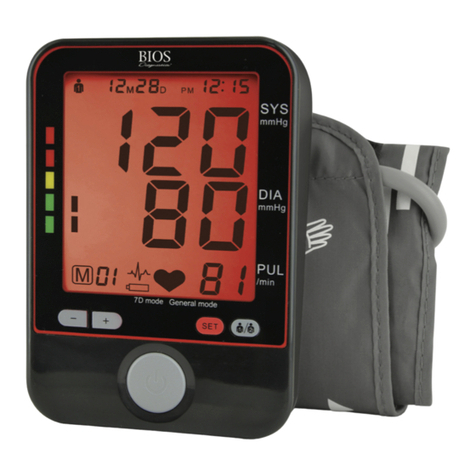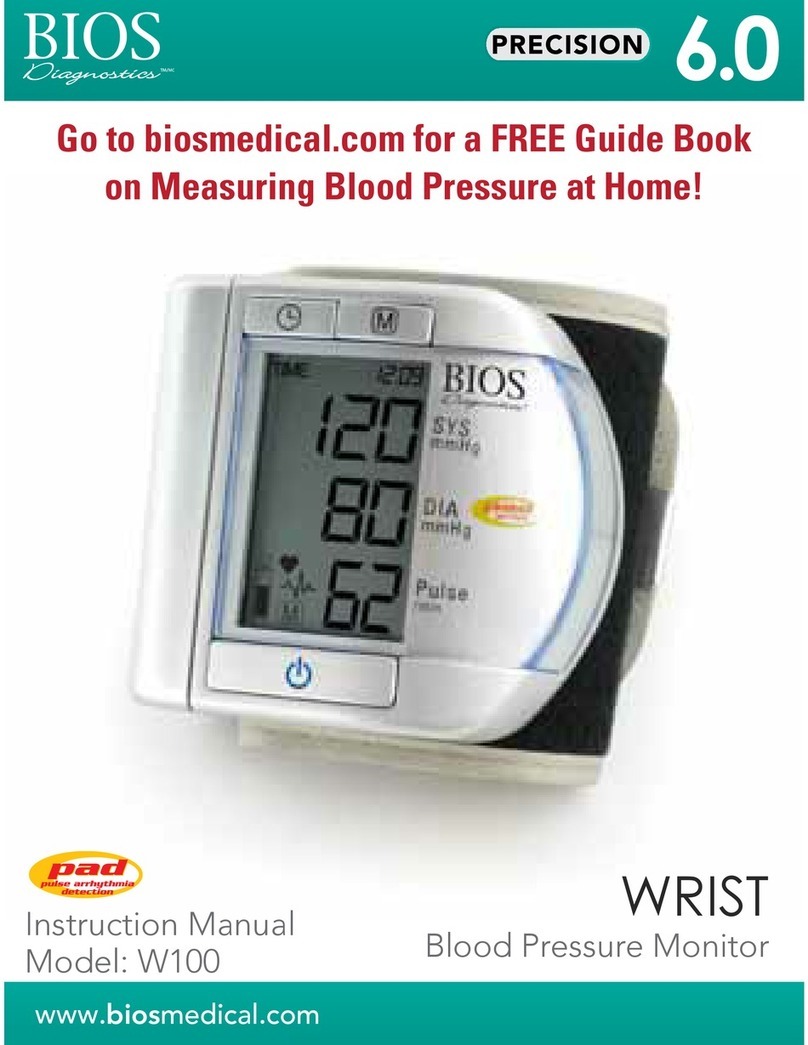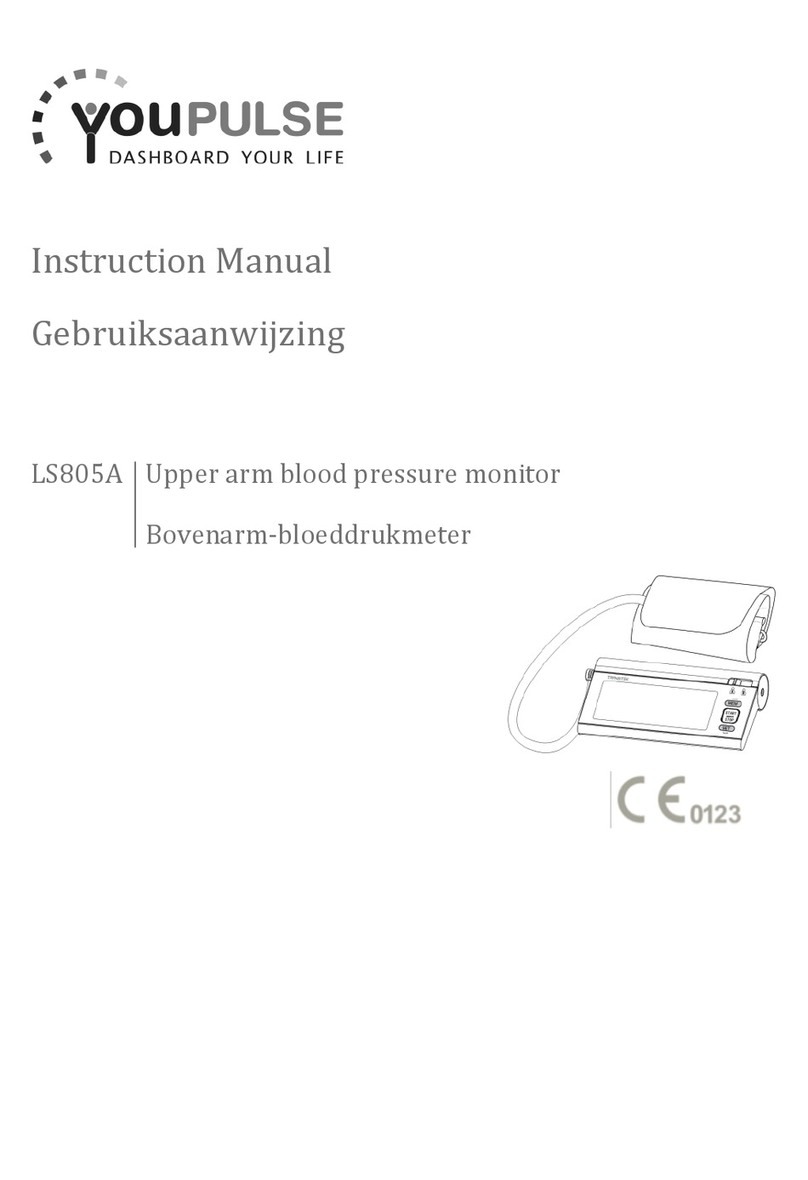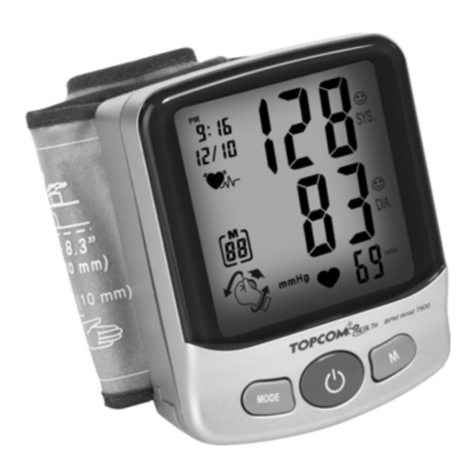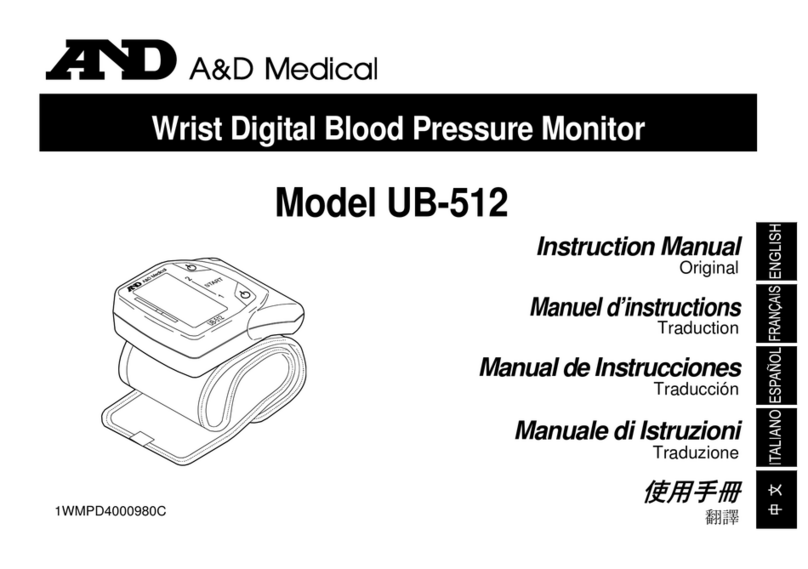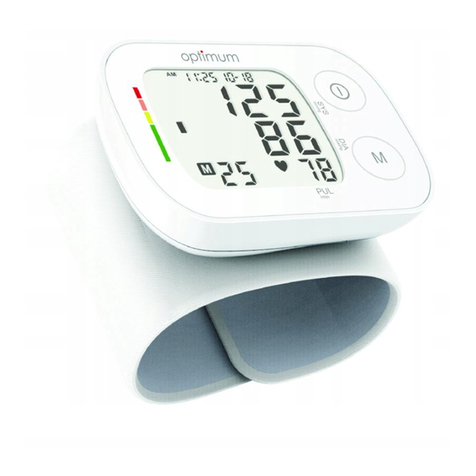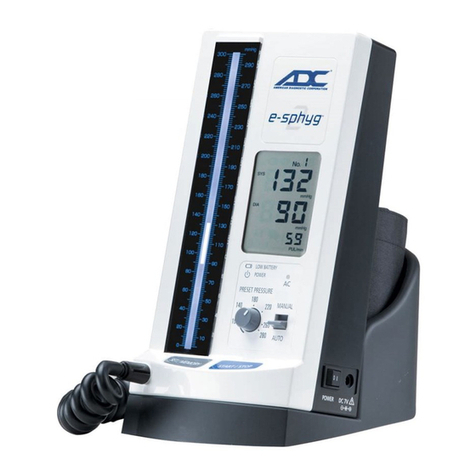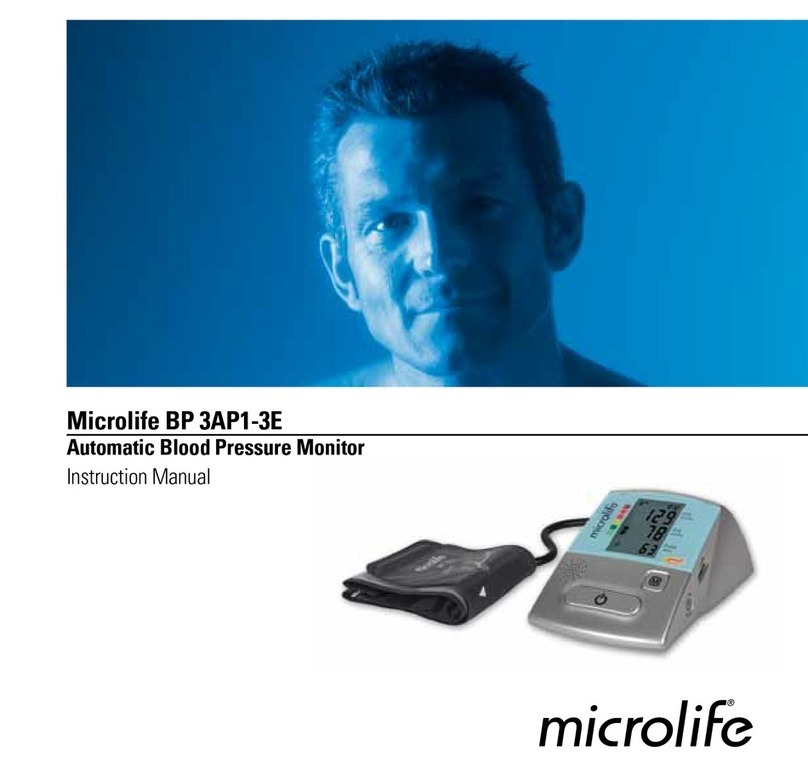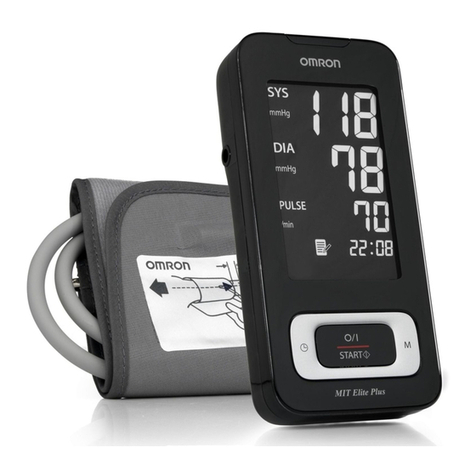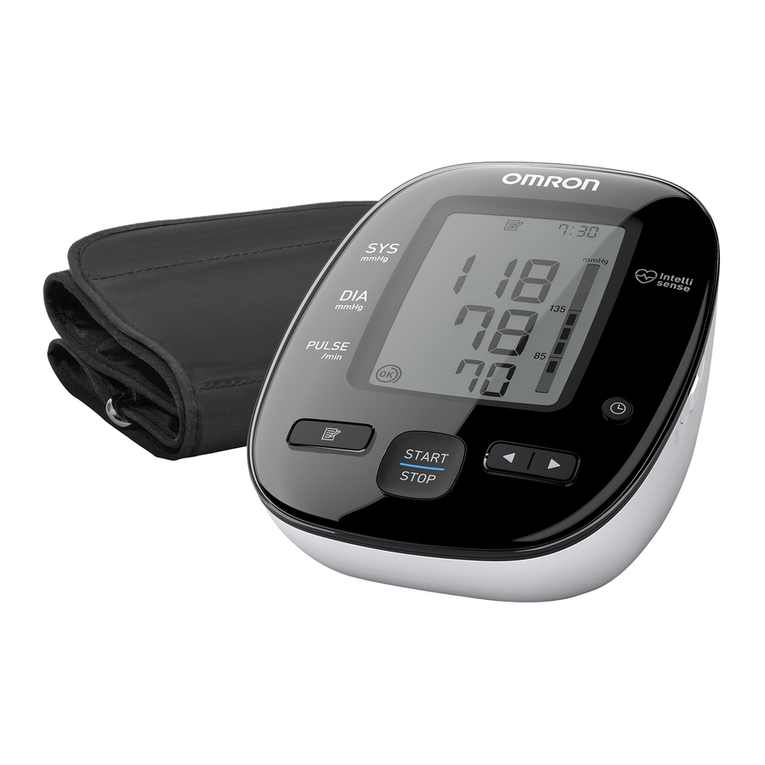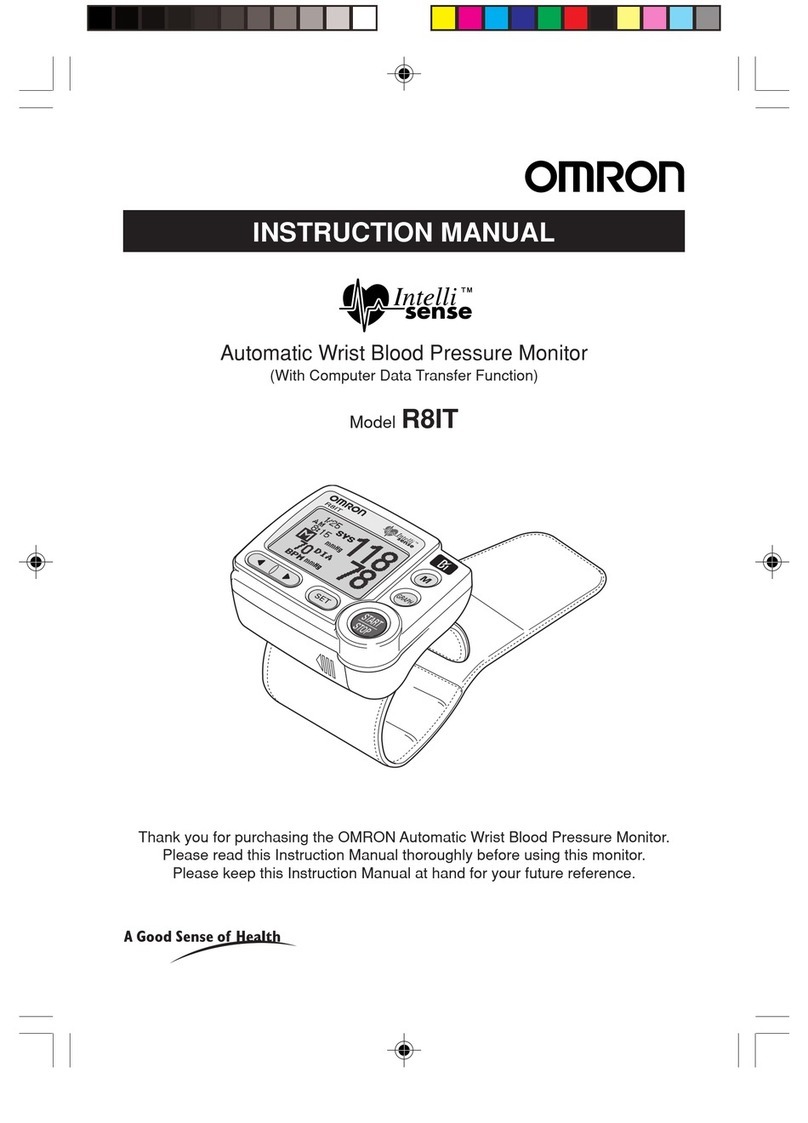BIOS 3MS1-4K User manual

Instruction Manual
Model: 3MS1-4K
Blood Pressure Monitor
with Atrial Fibrillation
Screening
www.biosdiagnostics.com
Go to biosdiagnostics.com for a FREE Log Book!
PRECISION SERIES

Trusted by Canadians for 3 Generations.
At BIOS Diagnostics, we are proud of our legacy in blood pressure monitoring across
Canada. From the early 1930’s to 1987 we manufactured Tycos professional blood pressure
equipment for doctors and hospitals in Canada.
In the 1970’s we pioneered the first blood pressure devices for monitoring at home, and in
the 1980’s we introduced digital technology in Canada. We haven’t been counting, but we
know that millions of our home-use monitors have been used by Canadians in the last 25
years
All Bios Diagnostics devices are developed in collaboration with physicians and clinical tests
prove their measurement accuracy. For more information on clinical tests and other BIOS
medical products, visit our website at www.biosdiagnostics.com
If you have questions about this device or blood pressure monitoring at home, email us at:
Or: Call the BIOS Diagnostics Hotline 1-866-536-2289
Office and manufacturing plant, Church St,Toronto 1934

Table of Contents
1. Introduction
1.1 Features
1.2 Important Information
1.2A Safety Information
1.2B Care of the Device
1.3 About Blood Pressure
1.4 Normal Blood Pressure Values
1.5 Common Blood Pressure Questions and Answers
1.6 About MAM Technology
1.6A Why Use MAM?
1.6B Key Advantages
1.6C Medical Benefits
1.6D Measurement Sequence
1.7 Important Facts about Atrial Fibrillation (AFIB)
1.7A What is Atrial Fibrillation?
1.7B How Does AFIB Impact my Family or Me?
1.7C AFIB Detection Provides a Convenient Way to Screen for AFIB (only in MAM Mode)
1.7D Risk Factors you Can Control
2. Getting Started
2.1 About the 3MS1-4K
2.2 About the LCD Screen
2.3 Inserting the Batteries
2.4 Using the AC Adapter
3. Using the Device
3.1 Setting the Time and Date
3.2 Measurement Mode Selection (MAM or Single)
3.3 Obtaining Accurate Measurements
3.3A Before Measuring
3.3B Common Sources of Error
3.3C Fitting the Wide Range Cuff
3.4 Measuring your Blood Pressure
3.5 Appearance of the Atrial Fibrillation Indicator (only in MAM mode)
3.6 Viewing Previously Recorded Values
3.7 Clearing All Values
3.8 Discontinuing a Measurement
Ultra Blood Pressure Monitor with Atrial Fibrillation Screening
Instruction Manual

4. Software Functions
5. Error Messages / Malfunctions
6. Care and Maintenance
7. Lifetime Guarantee
8. Technical Specifications

1. Introduction
Thank you for purchasing the BIOS Diagnostics™Ultra Blood Pressure Monitor with Atrial Fibrillation Screening.
Designed for convenient and easy operation,this device provides a simple, yet accurate method to measure your
blood pressure.
Your blood pressure is an important parameter that can be used to monitor your health.This device enables you to
monitor your blood pressure regularly, and maintain a record of your blood pressure measurements.You can then
use this record to assist your physician in diagnosing and maintaining a healthy blood pressure level.
1.1 Features
The 3MS1-4K is a fully automatic,digital, blood pressure measuring device with a unique fuzzy logic technology as
well as patented MAM and AFIB technologies.It can store up to 200 blood pressure readings.
It provides a fast and reliable measurement of systolic and diastolic blood pressure as well as heart rate using the
oscillometric measurement method.
AFIB detection is the world’s leading digital blood pressure measurement technology for the early detection of atrial
fibrillation (AFIB) and hypertension.These are the two top risk factors of heart disease and stroke which increase
the risk of getting a stroke or heart disease in the future. It is important to detect AFIB and hypertension at an early
stage, even though you may not experience any symptoms.Appropriate treatment can reduce your risk of suffering
a stroke.For this reason, it is recommended that you visit your doctor when the device gives an AFIB signal during
your blood pressure measurement.The AFIB algorithm has been clinically investigated by several prominent clinical
investigators and showed that the device detects patients with AFIB at 97-100% certainty.
MAM - Averaging Mode technology used in the device provides accurate measurements. Using three
consecutive measurements,your result is calculated and displayed as a single averaged measurement on
the display screen.
AFIB -Atrial Fibrillation Detector technology icon is displayed when atrial fibrillation is detected during
a blood pressure reading.
• Blood Pressure Analyzer Software allows you to download,record and chart your readings to accurately
monitor your daily readings.The Blood Pressure software can be downloaded for free from
www.biosdiagnostics.com
This powerful medical tool automatically stores all your blood pressure readings. By clicking the viewing
options the user can review the readings in multiple forms including: by date,morning vs. evening readings,
isolated systolic or diastolic or pulse.The automatic graph clearly shows your blood pressure history with highs
and lows. Charts and graphs can even be printed or emailed to your doctor!
This device is easy to use and has been proven in clinical studies to provide excellent accuracy. Before using the
3MS1-4K, read this instruction manual carefully and keep it in a safe place.
1.2 Important Information
Refer to the following sections to learn about important safety instructions and how to take care of the
BIOS Diagnostics™Premium Blood Pressure Monitor with Atrial Fibrillation Screening.
1.2A Safety Information
• Self-measurementmeanscontrol,notdiagnosisortreatment.Yourvaluesmustalwaysbediscussedwithyour
doctor or a physician who is familiar with your family history.

• Ifyouareundergoingmedicaltreatmentandreceivingmedication,consultyourdoctortodeterminethemost
appropriate time to measure your blood pressure. Never alter the dosages of any medication without direction
from your doctor.
• Yourbloodpressuredependsonseveralfactors,suchasage,gender,weight,andphysicalcondition.Italso
depends on the environment and your state of mind at the time of measurement. In general, your blood
pressure is lower when you are asleep and higher when you are active.Your blood pressure may be higher
when recorded at a hospital or a clinic and may be lower when measured in the relaxing comfort of your home.
Due to these variations, we recommend that you record your blood pressure regularly at home as well as at
your doctor’s clinic.
• Trytorecordyourbloodpressureregularlyatthesametimeofthedayandunderthesameconditions.Thiswill
help your physician detect any extreme variations in your blood pressure and thus treat you accordingly.
• MorningHypertension(>135/85mmHg):Recently,severalstudieshaveidentiedelevatedcardiovascular
risks (heart failure,stroke,angina) associated with “morning hypertension”. There is a typical rise in blood
pressure during the physiological changes from sleep to arising for the day.
• Theidealtimetomeasureyourbloodpressureisinthemorningjustafteryouwakeup,beforebreakfast
and any physical activity, and in the absence of the urge to urinate. If this is not possible, try to take the
measurements later in the morning,before you start any physical activity. Relax for a few minutes before you
record your blood pressure.
• Yourbloodpressureincreasesordecreasesunderthefollowingcircumstances:
Blood pressure is higher than normal:
— when you are excited,nervous, or tense
— while taking a bath
— during and after exercise or strenuous physical activity
— when it is cold
— within one hour after meals
— after drinking tea,coffee, or other caffeinated drinks
— after smoking tobacco
— when your bladder is full
Blood pressure is lower than normal:
— after consuming alcohol
— after taking a bath
• Thepulsedisplayisnotsuitableforcheckingthefrequencyofheartpacemakers.
• Ifyouhavebeendiagnosed with a severe arrhythmia or irregular heartbeat, vascular constriction, liver
disorders, or diabetes, have a cardiac pacemaker, or are pregnant, measurements made with this instrument
should only be evaluated after consultation with your doctor.
• Takecarewhilehandlingthebatteriesinthedevice.Incorrectusagemaycausebatteryuidleakage.
To prevent such accidents, refer to the following instructions:
— Insert batteries with the correct polarity.
— Turn off power after use.Remove and store the batteries if you are not planning to use the device for an
extended period of time.
— Do not mix different types,brands, or size of batteries.This may cause damage to the product.
— Do not mix old and new batteries.
— Remove batteries and dispose of them according to the proper regulations in your area.
— Do not disassemble batteries or expose them to heat or fire.

— Do not short-circuit the batteries.
— Do not use rechargeable batteries.
1.2B Care of the Device
For prolonged life of your blood pressure monitor,note the following instructions:
• Donotdroporbangtheunit.Preventsuddenjerks,jars,orshockstothedevicetopreventdamage.
• Donotinsertanyforeignobjectsinanydeviceopeningsorvents.
• Donotdisassembletheunit.
• Iftheunithasbeenstoredatveryloworfreezingtemperatures,allowtoreachroomtemperaturebeforeusing
it.
• Donotstoretheunitindirectsunlight,highhumidity,orinplaceswithalotofdust.
• Cleanthedevicewithasoftdrycloth.Donotusegasoline,thinnerorsimilarsolvents.Carefullyremovespots
on the cuff with a damp cloth and soap. Do not wash the cuff.
1.3 About Blood Pressure
Your blood pressure level is determined in the circulatory center of your brain.Your nervous system allows your body
to adapt or alter blood pressure in response to different situations.Your body alters your pulse or heart rate and the
width of blood vessels through changes in muscles in the walls of blood vessels.
Your blood pressure reading is highest when your heart pumps or ejects blood.This stage is called your systolic
blood pressure.
Your blood pressure is lowest when the heart rests (in-between beats).This is called your diastolic blood pressure.
It is critical to maintain blood pressure values within a “normal” range in order to prevent cardiovascular diseases.
Increased blood pressure values (various forms of hypertension) have associated long and medium term health
risks.These risks concern the arterial blood vessels of your body, which are endangered due to constriction caused by
deposits in the vessel walls (arteriosclerosis).A deficient supply of blood to important organs (heart, brain, muscles)
can be the result. Furthermore,with long-term increased blood pressure values, the heart will become structurally
damaged.
There are many different causes of the appearance of high blood pressure.We differentiate between common
primary (essential) hypertension, and secondary hypertension. The latter group can be ascribed to specific organic
malfunctions. Please consult your doctor for information about the possible origins of your own increased blood
pressure values.
1.4 Normal Blood Pressure Values
Bloodpressureistoohighwhen,atrest,thediastolicpressureisabove90mmHgorthesystolicbloodpressureis
over140mmHg.
Ifyouobtainreadingsinthisrange,consultyourdoctorimmediately.Highbloodpressurevaluesovertimecan
damage blood vessels, vital organs such as the kidney, and your heart.
Shouldthesystolicbloodpressurevaluesliebetween140mmHgand160mmHgorthediastolicbloodpressure
valuesliebetween90mmHgand95mmHg,consultyourdoctor.Regularself-checkswillbenecessary.
Withbloodpressurevaluesthataretoolow(i.e.,systolicvaluesunder105mmHgordiastolicvaluesunder
60mmHg),consultwithyourdoctor.
Even with normal blood pressure values, a regular self-check with your blood pressure monitor is recommended.

This way you can detect possible changes in your values early and react appropriately.
Refertothefollowingtableforclassifyingbloodpressurevalues(units:mmHg)accordingtotheWorldHealth
Organization(WHO):
Category Systolic Blood Pressure Diastolic Blood Pressure
Optimal < 120 < 80
Normal < 130 < 85
HighNormal 130 - 139 85 - 89
Hypertension
•Stage1:Mild
•Stage2:Moderate
•Stage3:Severe
140 - 159
160 - 179
>180
90 - 99
100 - 109
>110
IsolatedSystolicHypertension >140 < 90
Important for Canadians: The Canadian Hypertension Education Program (CHEP) recommends that
patients with average measurements of 135mmHg (systolic) or 85mgHg (diastolic) at home be
considered hypertensive. Should your average readings be in this range, consult your physician.
For further information, see our website www.biosdiagnostics.com.
Further information
If your values are mostly “normal” under resting conditions but exceptionally high under conditions of physical or
psychological stress,it is possible that you are suffering from so-called ”labile hypertension”. In any case,please
discuss the values with your doctor.
Correctlymeasureddiastolicblood-pressurevaluesabove120mmHgrequireimmediatemedicaltreatment.
1.5 Common Blood Pressure Questions and Answers
a) Why is my blood pressure reading always different?
Yourbloodpressurechangesconstantly.Itisquitenormalforbloodpressuretofluctuatesignificantly(50mmHg
to60mmHg)throughouttheday.Bloodpressureisnormallylowestatnight,butincreasesduringwakinghours
when the stress and activities of everyday life are highest.
mmHg
AM Time PM

Your blood pressure also increases and decreases under the following circumstances
Blood pressure is higher than normal:
•whenyouareexcited,nervous,ortense
•whiletakingabath
•duringandafterexerciseorstrenuousphysicalactivity
•whenitiscold
•withinonehouraftermeals
•afterdrinkingtea,coffee,orothercaffeinateddrinks
•aftersmokingtobacco
•whenyourbladderisfull
Blood pressure is lower than normal:
•afterconsumingalcohol
•aftertakingabath
b) Why is the doctor’s reading different from the reading taken at home?
Your blood pressure can vary due to the environment (temperature, nervous condition). When measuring
blood pressure at the doctor’s office, it is possible for blood pressure to increase due to anxiety and tension.
c) Why should I monitor blood pressure at home?
One or two readings will not provide a true indication of your normal blood pressure.It is important to take
regular, daily measurements and to keep records over a period of time. This information can be used to
assist your physician in diagnosing and preventing potential health problems.
1.6 About MAM Technology
(Average Mode) technology is a new technology that enables optimum reliability in self-measurement of
blood pressure.
An advanced measurement accuracy is achieved by the automatic analysis of three successive measurements,with
short rest periods in between (see diagram 1).
This new technology provides reliable values for the doctor and can be used as the basis for reliable diagnostics and
medication therapy for high blood pressure.
• Reliablepatientself-measurementdataforthedoctor
• Safehypertensiondiagnostictool
• Reliabletherapycontrol
1.6A Why Use MAM?
• Humanbloodpressureisnotstable
1.6B Key Advantages
The technology provides reduction in:
• Devicescattering
• Insufcientrestpriortomeasurement
• Movementeffects(i.e.coughing,talking,movement)
• Cuffpositioninginuences

1.6C Medical Benefits
• Improved accuracy
1.6D Measurement Sequence
• Single results are not displayed
• Duetothe“DataAnalysis”result,a4thor5thmeasurementmaybeapplied.Thefollowingillustrationprovides
aowchartoftheMAMSequence
Diagram 1
1.7 Important facts about atrial fibrillation (AFIB)
1.7A What is Atrial Fibrillation (AFIB)?
Normally, your heart contracts and relaxes to a regular beat. Certain cells in your heart produce electrical signals that
cause the heart to contract and pump blood.Atrial fibrillation occurs when rapid, disorganized electrical signals are
present in the heart’s two upper chambers, called the atria; causing them to contract quickly and irregularly (this is
called fibrillation).Atrial fibrillation is the most common form of heart arrhythmia or irregular heart beat.You can
live with atrial fibrillation, but it can lead to other rhythm problems,chronic fatigue, heart failure and - worst of all - a
stroke.You’ll need a doctor to help you control the problem.
1.7B How does AFIB impact my family or me?
One in every six strokes is AFIB-related. While individuals above the age of 65 are more likely to have AFIB,
individuals as young as 40 can exhibit AFIB. Early diagnosis can help reduce the risk of a stroke.
1.7C AFIB detection provides a convenient way to screen for AFIB (only in MAM mode)
Knowing your blood pressure and knowing whether or not you or your family members have AFIB can help reduce
the risk of stroke.AFIB detection provides a convenient way to screen for AFIB while taking your blood pressure.
1.7D Risk factors you can control
HighbloodpressureandAFIBarebothconsidered«controllable»riskfactorsforstrokes.Knowingyourblood
pressure and knowing whether or not you have AFIB is the first step in proactive stroke prevention.

2. Getting Started
2.1 About the 3MS1-4K
a) This section describes the various components of the Blood Pressure Monitor.
b) Upper arm cuff:
Type BD051 wide range cuff for arm circumference 22-42 cm or 8.75” - 16.5”.
Cuff connection:
Insert the cuff tube into the opening provided on the left side of the monitor as shown in the diagram.

2.2 About the LCD Screen
The LCD screen displays the systolic and diastolic blood pressure measurements along with your heart rate. It also
displays previously recorded measurements and the date and time, when the appropriate button is pressed.
Atrial Fibrillation
MAM Averaging
Please wait in between measurements
Heartbeat during measurement
Memory
Low battery
Symbol Guide
2.3 Inserting the Batteries
Follow these steps to insert the four “AA” batteries in the device.
1. Open the battery compartment cover in the direction shown.
2. Insert the four “AA” batteries with the correct polarity as indicated.
3. Replace the battery compartment cover.
Attention!
• Afterthebatterywarningappears,the
device is blocked until the batteries have been replaced.
• Pleaseuse“AA”Long-LifeorAlkaline1.5Vbatteries.
• Ifthebloodpressuremonitorisleftunusedforlongperiods,pleaseremovethe
batteries from the device.
• Donotmixoldandnewbatteries.Donotmixalkaline,standard(carbon-zinc)or
rechargeable batteries.

2.4 Using the AC Adapter
You may also operate this monitor using the
includedACadapter(output6VDC/600mAwith
DIN plug). Use only the included AC adapter to
avoid damaging the unit.
1. Ensure that the AC adapter and cable are not
damaged.
2. Plug the adapter cable into the AC adapter port
on the blood pressure monitor.
3. Plug the adapter into your electrical outlet.When the AC adapter is connected, no battery current is consumed.
Note: No power is taken from the batteries while the AC adapter is connected to the monitor. If electrical power
is interrupted, (e.g., by accidental removal of the AC adapter from the outlet) the monitor must be reset by
removing the plug from the socket and reinserting the AC adapter connection.
Functional check:Holdthe button down to test all the display elements.When functioning correctly all
segments must appear.
3. Using the Device
This section describes how to get the maximum benefit from your 3MS1-4K blood pressure monitor. Follow the
instructions carefully to get an accurate measurement of your blood pressure and pulse rate.
3.1 Setting the Time and Date
When you insert the batteries for the first time (see “Inserting the batteries”), the monitor
prompts you to set the current date and time.You can also adjust the date and
time by pressing and holding down the button for over 3 seconds.Follow these steps
to set the date and time settings:
1. When you press the buttonforover3seconds,theyearwillstartashing.Pressthe
button to adjust the year and press the button to confirm setting.
2. Next,thescreenstartsashingthemonthsetting.Pressthe button repeatedly to
set the month and then press the button to confirm the settings. Follow the same
steps to set the date setting.
3. Lastly,thescreenstartsashingthehourvalues.Pressthe button repeatedly to set
the hour and then press the button to confirm the settings. Follow the same steps
to set the minute values.
MONTH-DATE
TIME

3.2 Measurement Mode Selection (MAM or single)
Clinical studies demonstrate taking multiple blood pressure readings and calculating an “average” is more likely to
determine your true blood pressure.Your premium blood pressure unit allows you to switch the unit to an Average
Mode setting that automatically takes multiple readings!
Average Mode Slide Switch (MAM):
a) If you would like to take an Average Mode measurement, move the slide switch to
the right.
b) Average Mode takes 3 measurements in succession and calculates the result and
displays it as a single average measurement.A symbol in the display indicates that the unit is set to the
Average Mode.
c) There will be 15 seconds resting time in-between each measurement.The unit will count down from 15 seconds.
A beep will sound at the last 5 seconds to remind you that the unit is about to take another measurement.If one
of the measurements causes an error message, it will be repeated one more time. If any additional error occurs the measurement will be
discontinued and error code displayed.
Note: AFIB detection can only be done in MAM mode.
Single mode
a) If you would like to take a single mode measurement, please move the slide
switch to the left.
b) Single mode only has 1 measurement.
3.3 Obtaining Accurate Measurements
Your blood pressure can vary based on numerous factors, physiological conditions, and your surroundings. Follow
these guidelines to obtain accurate and error-free measurements of your blood pressure and pulse rate.
3.3A Before Measuring
• Avoideating,smokingaswellasallformsofexertiondirectlybeforethemeasurement.Allthesefactors
inuencethemeasurementresult.Relaxbysittinginanarmchairinaquietatmosphereforabout5minutes
before the measurement.
• Alwaystakemeasurementsonthesamearm(normallyleft)andinthesameposture.Donotswitchbetween
rightandleftarmswhilerecordingyourbloodpressureastheremaybeadifferenceofupto10mmHg
pressure between the two arms.
• Attempttocarryoutthemeasurementsregularlyatthesametimeofday,sincebloodpressurechangesduring
the course of the day. The ideal time to measure your blood pressure is in the morning after you wake up,
before breakfast and physical activity,and in the absence of the urge to urinate.
• Restfor5minutessittingquietlyandreleaseallthetensioninyourbody—especiallythearmmuscles—before
beginning with the measurement.Remain calm and quiet when the measurement is in process. Do not speak
or move your arm (as well as other body) muscles during the process.
3.3B Common Sources of Error
All efforts by the patient to support the arm can increase the blood pressure. Make sure you are in a comfortable,
relaxed position and do not activate any of the muscles in the measurement arm during the measurement.Use a
cushion for support if necessary.

ATTENTION!
Comparable blood pressure measurements always require the same conditions with a peaceful and
calm environment. Ensure that you take measurements under the same conditions to obtain an
accurate estimate of blood pressure variation patterns.
• Ifthearmarteryliesconsiderablylowerorhigherthantheheart,anerroneousvalueofbloodpressureis
measured.Each15cmdifferenceinheightresultsinameasurementerrorof10mmHg.
• Aloosecuffcausesfalsemeasurementvalues.
• Withrepeatedmeasurements,bloodaccumulatesinthearm,whichcanleadtofalseresults.Consecutive
blood pressure measurements should be repeated after at least a 15 second pause or after the arm has been
heldupinordertoallowtheaccumulatedbloodtoowaway.
3.3C Fitting the Wide Range Cuff
a) Put the end of the cuff (with fastener) through the metal ring,
making the cuff a cylinder.(Ignore this step if your cuff is already
set up.) Proper assembly allows the Velcro®to match up properly.
b) Place the cuff around your arm. Make sure the bottom edge of
the cuff is about 1” above the elbow joint. Adjust the cuff so that
the rubber tubing under the cuff lies over the brachial artery,
which runs on the inside of the arm (see Fig. C).
c) Pull the cuff and tighten it by attaching the Velcro®fastener.
Normally, the left arm is used,unless there is a physical reason
for using the right arm.
d) The cuff should fit snugly around the arm, but not too tight.You
should be able to fit two fingers under the cuff.
e) Place the arm on the table (palm facing upwards) so that the cuff
is at the same level as the heart. Make sure there is no kink in the
hose.
a)
b)
c)
d)
e)

f) You can adjust the level of your arm by putting a cushion under
your arm.
g) Remain seated in a comfortable room temperature for at least 5
minutes, then start the measurement.
h) For those who cannot put the cuff on the left arm, put it on the right
arm as shown.
i) Consecutive measurements will cause blood accumulation in
the lower arm which will affect the measuring results.To improve
reading accuracy,raise the arm being measured,squeeze and relax
your hand several times, then take another measurement.Another
option is to take the cuff off and wait at least 10 minutes before
repeating measurement.
j) If this device was stored in low temperature, it is necessary to leave it
in room temperature for at least 1 hour, otherwise the measurement
can be inaccurate.
Comment:
If it is not possible to fit the cuff to your left arm, it can also be placed on the right
arm.Howeverallmeasurementsshouldbemadeusingthesamearm.
Comparable blood pressure measurements always require the same conditions
(Relax for several minutes before taking a measurement).
ATTENTION: Do not use cuff other than the original cuff contained in this kit!
g)
h)
i)
f)

3.4 Measuring Your Blood Pressure
After following the guidelines described in the previous section and placing the cuff
around your upper arm, you are now ready to measure your blood pressure. Follow these
steps to record your measurement.
1. Press the button to turn on the device and start measurement.The LCD screen is
turnedon.Thecuffbeginstoinatewhiletheincreasingcuffpressureisdisplayedon
thescreen.Afterthesuitableinationpressureisreached,thecuffstopsinatingand
the pressure gradually falls. A long beep sounds when the measurement is completed.
The systolic and diastolic blood pressure values along with the pulse rate are displayed
on the screen.The measurement is displayed for approximately 1 minute.
2. Switch off the device by pressing the button to preserve the batteries. If no button is
pressed for 1 minute,the instrument switches the display off.
NOTE: The time will continuously be displayed on the screen.
3.5 Appearance of the Atrial Fibrillation Indicator (only in MAM mode)
This symbol indicates that atrial fibrillation was detected during the measurement.If AFIB is present during
blood pressure measurement, the AFIB Indicator is displayed.The AFib willash8timesrapidlyoncethe
measurementiscompleteandthenstopashing.Inthiscase,theresultmaydeviatefromyournormalblood
pressure.It is highly recommended to take an additional measurement an hour later to increase the specificity of the
detection.Inmostcases,thisisnocauseforconcern.However,ifthesymbolappearsonaregularbasis(e.g.several
times a week with measurements taken daily) we advise you to visit your doctor.Please, provide the following
explanation:
Information for the doctor on frequent appearance of the atrial fibrillation indicator
This instrument is an oscillometric blood pressure monitor that also analyses pulse frequency during measurement.
The instrument is clinically tested.
The symbol is displayed after the measurement, if atrial fibrillation occurs during measurement. If the symbol
appears more frequently (e.g.several times per week on measurements performed daily) we recommend the
patient to seek medical advice.The instrument does not replace a cardiac examination, but serves to detect atrial
fibrillation at an early stage.
• Sometimesthedevicewilldetectatrialbrillationevenwhenitisnotthere.Thiscanhappenifthearmmoves
during the reading or another rhythm problem is present. Keep the arm still during the reading.Visiting your
doctor with this device may be necessary to check out any rhythm problems.
• Thisdevicemaynotdetectatrialbrillationinpeoplewithpacemakersordebrillators.
3.6 Viewing Previously Recorded Values
The blood pressure monitor automatically stores your measurements. It can store up to 200 measurements.When
more than 200 measurements are made, the oldest readings are deleted to make space for the new ones.
To view the previously stored values, press the button.The last measurement is displayed.The date and time of
the measurement are also displayed after the reading. Press the button repeatedly to view all the measurements
that are recorded on the device.
Note: Blood pressure measurements are not stored when an error is encountered during
measurement.

3.7 Clearing All Values
If you are sure that you want to permanently remove all stored values, hold down the button (the
instrument must have been switched off before hand) until the “CL” appears and then release the
button.If you do not want to clear the values, press the button.To permanently clear the memory,
press the button while “CL” is flashing. Individual values cannot be cleared.
3.8 Discontinuing a Measurement
If it is necessary to interrupt a blood pressure measurement for any reason (e.g. the patient feels unwell), the
button can be pressed at any time.The device then immediately lowers the cuff pressure automatically.
4. Software Functions
This unit can be used in connection with your personal computer (PC) running the PC Link Blood Pressure Analyzer
Software.The software will allow a capacity of monitoring 80 patients, each with 1000 data (Note: overuse will lower
system efficiency).The memory data can be transferred to the PC by connecting the monitor via USB cable with your
PC.
NOTE: The software does not work with Mac Computers.
NOTE: The USB cable can be purchased at any electronics store. You will need USB cable Mini-B 5 pin. USB versions
1.0 or 2.0 will work on this device.
System Requirements:
This software is compatible with Microsoft®Windows®XP/Vista/Windows7andsupports32and64bitoperating
systems.
To download the software go to www.biosdiagnostics.com. Go to the support page and download “3MS1-4K Link
Software 3.2.5.E”.Follow the directions to download the software.
Once installation is complete connect the monitor via USB cable with the PC.Three horizontal bars will appear on the
display and last for 3 seconds.
The bars will then flash to indicate that the connection between computer and device is successfully made.As long
asthecableispluggedin,thebarswillkeepashingandthebuttonsaredisabled.
During the connection, the device is completely controlled by the computer.Please refer to the ‘help’ file in the
software for detailed instructions.
5. Error Messages / Malfunctions
If an error occurs during a measurement, a long beep followed by two short beeps is generated and the LCD display
the corresponding error code.
Error Possible Cause Remedy
Err 1 No pulse has been detected. Ensure that the cuff is being worn correctly, and
that you have your arm at the heart level.
Err 2 Unnaturalpressureimpulsesinuencethemea-
surement result.Reason: The arm was moved
during the measurement.
Avoid unnecessary movement or talking.
Err 3 Theinationofthecufftakestoolong.Thecuff
is not correctly seated.
Ensure that the cuff is being worn correctly.

Err 5 The difference between systolic pressure and
diastolic pressure is too far away from accept-
able and reasonable range.
Ensure that the cuff is being worn correctly and
that you have been inactive for a sufficient time
before making the measurement.
Err 6 Due to unstable conditions during measure-
ments, it is not possible to calculate an average
result.
Avoid unnecessary movement and talking.
Low battery Replace batteries.
Hi Cuffpressureisover300mmHgorpulseisover
200 beats per minute.
Ensure that the cuff is worn correctly and mea-
sure again.Avoid movement or talking when
thecuffisbeinginated.
Lo Pulse below 40 is detected. Ensure that the cuff is worn correctly.
If problems occur when using the device the following points should be checked, and if necessary, the
corresponding measures should be taken.
Malfunction Remedy
The display remains empty when the device is switched
on.The batteries are inserted.
1. Check batteries for correct polarity.
2. If the display is unusual, re-insert the batteries or
exchange them for new ones.
The pressure does not rise even though the pump is
running.
Check the connection of the cuff tube and connect
properly if necessary.
The device frequently fails to measure the blood
pressure values,or the values measured are too low
or too high.
1. Check the positioning of the cuff.
2. Measure the blood pressure again, ensuring that
you have remained motionless for a sufficient
amount of time to ensure an accurate reading.
Every measurement produces varying results although
the instrument functions normally and the values
displayed are normal.
Notethatbloodpressureuctuatescontinuously;
therefore measurements will show some variability.
Blood pressure values measured differ from those
measured by the doctor.
Record the daily developement of the values and
consult your doctor.
Note: Individuals visiting their doctor fre-
quently experience anxiety which can result in
a higher blood pressure reading than at home.

6. Care and Maintenance
a) Do not expose the device to either extreme temperatures, humidity, dust or
direct sunlight.
b)Thecuffcontainsasensitiveair-tightbubble.Handlethiscarefullyandavoidall
types of stress through twisting or buckling.
c) Clean the device with a soft, dry cloth.Do not use gas, thinners or similar
solvents. Spots on the cuff can be removed carefully with a damp cloth and
soapsuds. The cuff with bladder must not be washed in a dishwasher,
clothes washer, or submerged in water.
d)Handlethetubecarefully.Donotpullonit.Donotallowthetubingtokinkand
keep it away from sharp edges.
e) Do not drop the monitor or treat it roughly in any way.Avoid strong vibrations.
f) Never open the monitor. This invalidates the manufacturer’s warrantee.
g) Batteries and electronic instruments must be disposed of in accordance with the locally applicable regulations,
not with domestic waste.
This manual suits for next models
1
Table of contents
Other BIOS Blood Pressure Monitor manuals



